The Virtual Online Supermarket: An Open-Source Research Platform for Experimental Consumer Research
Abstract
1. Introduction
2. VOS in a Nutshell: Features and Functions
2.1. Shop View
2.2. Visual Administration Interface (VAI)
2.3. Preconfigured Modification Options (“Use Cases”)
2.3.1. Use Case One: Taxes and Subsidies
2.3.2. Use Case Two: Product Arrangement
2.3.3. Use Case Three: Product Labels and Scores
2.3.4. Use Case Four: Virtual Shopping Carts
2.3.5. Use Case Five: Swap Options
2.4. Data Recording: Behavioral Outputs and Instore Behavioral Dynamics
3. Using a VOS: Results from a Pilot Study
3.1. Procedure
3.2. Results and Discussion
3.2.1. User Experience
3.2.2. Purchase Data
3.2.3. In-Store Behavior
4. Conclusions
Supplementary Materials
Author Contributions
Funding
Institutional Review Board Statement
Informed Consent Statement
Data Availability Statement
Acknowledgments
Conflicts of Interest
Appendix A. Brief Information about Technology and Programming
Appendix A.1. Application Development Frameworks
Appendix A.2. Model View Controller (MVC)
Appendix A.3. Front-End Programming
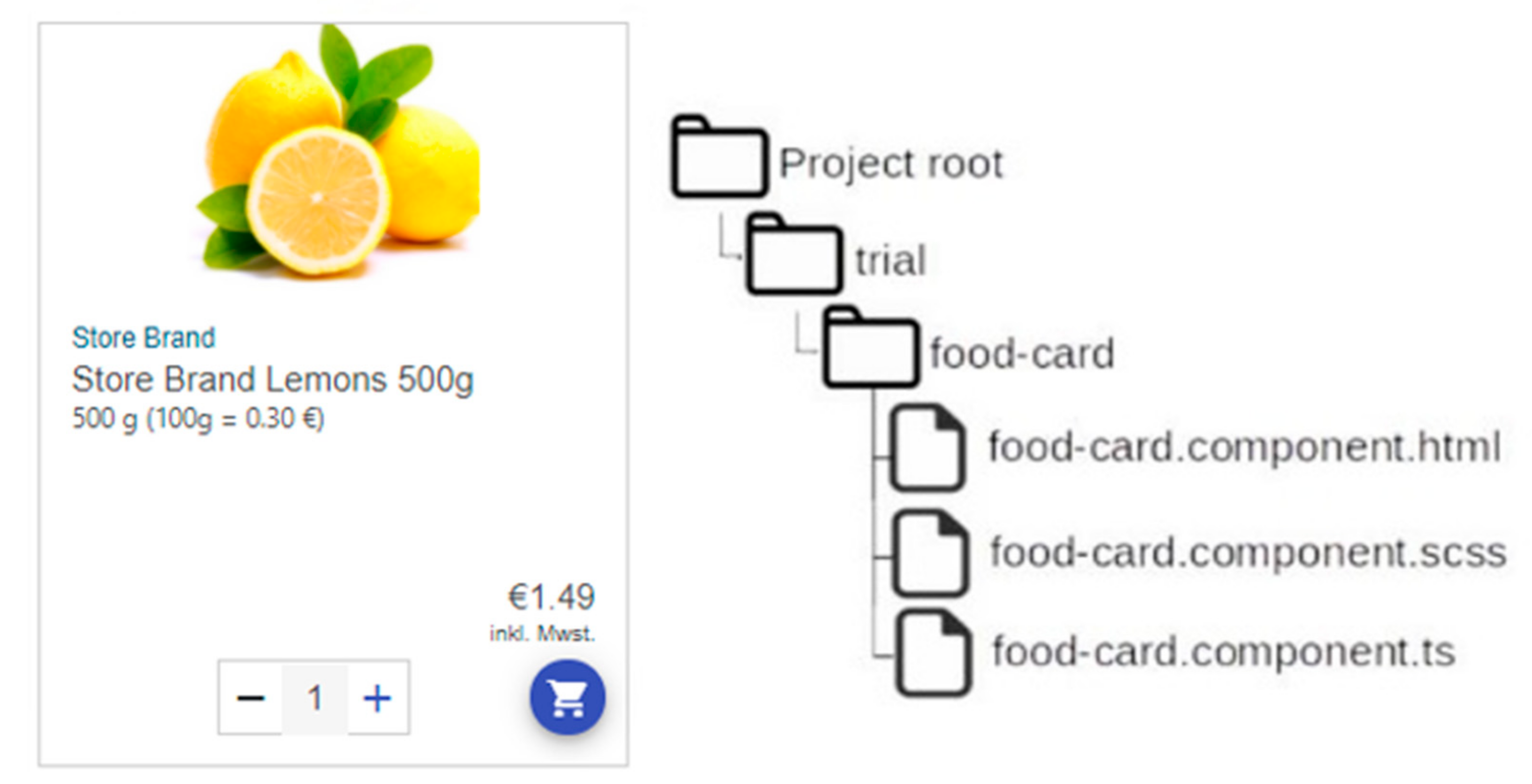
Appendix A.4. Back-End Programming

Appendix A.5. Availability
Appendix B
| ID | Description | Mean | Median | SD |
|---|---|---|---|---|
| Please rate the following statements: | ||||
| GS.01 | I am satisfied with my shopping experience in this online supermarket. | 4.89 | 6.00 | 1.55 |
| GS.02 | Overall, my expectations of shopping in this online supermarket have been met. | 4.86 | 5.00 | 1.26 |
| GS.03 | I would buy food from a real online supermarket similar to this VOS. | 4.93 | 5.00 | 1.46 |
| Please rate the understandability of the product information provided in the store. Product information provided in the store was generally… | ||||
| IQ.01 | … unambiguous. | 5.50 | 6.00 | 0.92 |
| IQ.02 | … easy to read. | 5.64 | 6.00 | 1.25 |
| IQ.03 | … comprehensible. | 5.71 | 6.00 | 1.05 |
| IQ.04 | … in general, understandable for me. | 5.86 | 6.00 | 0.89 |
| With regard to reliability, the product information was… | ||||
| IQ.05 | … trustworthy. | 5.68 | 6.00 | 1.02 |
| IQ.06 | … accurate. | 5.71 | 6.00 | 0.85 |
| IQ.07 | … credible. | 5.68 | 6.00 | 0.86 |
| IQ.08 | … in general, reliable for making my purchase decision. | 5.86 | 6.00 | 0.71 |
| With regard to usefulness, the product information was… | ||||
| IQ.09 | … informative for my purchase decision. | 4.86 | 5.00 | 1.35 |
| IQ.10 | … valuable for making my purchase decision. | 5.18 | 6.00 | 1.25 |
| IQ.11 | … in general, useful for making my purchase decision. | 5.04 | 5.00 | 1.35 |
| Please rate the usability of the online store: | ||||
| SQ.01 | Responsiveness (e.g., the online shop reacts quickly to queries). | 6.00 | 6.00 | 1.25 |
| SQ.02 | Performance (e.g., loading times of text and graphics) | 6.04 | 6.00 | 1.20 |
| SQ.03 | Technological modernness in general | 5.36 | 6.00 | 1.51 |
| Please rate the user-friendliness of the online store with regard to whether… | ||||
| SQ.04 | … its layout is simple. | 5.71 | 6.00 | 1.54 |
| SQ.05 | … it is easy to use | 5.96 | 6.00 | 1.11 |
| SQ.06 | … it is well organized (e.g., functions are where you would expect them) | 5.36 | 6.00 | 1.70 |
| SQ.07 | … it is possible to see as many products as possible at a glance | 5.04 | 6.00 | 1.69 |
| SQ.08 | … it is possible to compare different products easily | 4.43 | 5.00 | 1.20 |
| SQ.09 | … multiple product images and display formats are available (e.g., zoomed images) | 4.61 | 5.00 | 1.51 |
| SQ.10 | … its design is clear | 5.61 | 6.00 | 1.10 |
| SQ.11 | … it is user-friendly in general | 5.07 | 6.00 | 1.63 |
| Navigation: The navigation on the site has made it possible… | ||||
| SQ.12 | … to easily go back and forth between pages. | 5.50 | 6.00 | 1.37 |
| SQ.13 | … to locate the information I need with just a few clicks. | 5.35 | 6.00 | 1.04 |
| SQ.14 | … to locate the products I prefer as quickly as possible. | 5.07 | 6.00 | 1.61 |
| SQ.15 | … to edit my shopping cart as quickly and easily as possible (e.g., to add products). | 5.79 | 6.00 | 1.32 |
| SQ.16 | … to easily navigate in general. | 5.68 | 6.00 | 1.19 |
| Please tell us to what extent you agree with the following statements: | ||||
| RL.01 | The design of the website has given me the feeling of using a real online store. | 5.32 | 6.00 | 1.59 |
| RL.02 | Product selections and the price of my total shopping cart corresponds to my regular shopping behavior. | 5.61 | 6.00 | 0.92 |
| RL.03 | The decisions I have made reflect exactly how I would behave on a regular shopping trip. | 4.93 | 5.00 | 1.65 |
| RL.04 | The information which I gathered while shopping reflects my behavior on a regular shopping trip. | 5.29 | 6.00 | 1.27 |
References
- Hertwich, E. Assessing the Environmental Impacts of Consumption and Production: Priority Products and Materials; UNEP/Earthprint: Hertfordshire, UK, 2010. [Google Scholar]
- Willett, W.; Rockström, J.; Loken, B.; Springmann, M.; Lang, T.; Vermeulen, S.; Garnett, T.; Tilman, D.; DeClerck, F.; Wood, A.; et al. Food in the Anthropocene: The EAT–Lancet Commission on healthy diets from sustainable food systems. Lancet 2019, 393, 447–492. [Google Scholar] [CrossRef]
- Hoek, A.; Pearson, D.; James, S.; Lawrence, M.; Friel, S. Healthy and environmentally sustainable food choices: Consumer responses to point-of-purchase actions. Food Qual. Prefer. 2017, 58, 94–106. [Google Scholar] [CrossRef]
- Guthrie, J.F.; Mancino, L.; Lin, C.-T.J. Nudging Consumers toward Better Food Choices: Policy Approaches to Changing Food Consumption Behaviors. Psychol. Mark. 2015, 32, 501–511. [Google Scholar] [CrossRef]
- Reisch, L.; Eberle, U.; Lorek, S. Sustainable food consumption: An overview of contemporary issues and policies. Sustain. Sci. Pr. Policy 2013, 9, 7–25. [Google Scholar] [CrossRef]
- Pitts, S.B.J.; Ng, S.W.; Blitstein, J.L.; Gustafson, A.; Niculescu, M. Online grocery shopping: Promise and pitfalls for healthier food and beverage purchases. Public Health Nutr. 2018, 21, 3360–3376. [Google Scholar] [CrossRef]
- Anesbury, Z.; Nenycz-Thiel, M.; Dawes, J.; Kennedy, R. How do shoppers behave online? An observational study of online grocery shopping. J. Consum. Behav. 2016, 15, 261–270. [Google Scholar] [CrossRef]
- Hartmann-Boyce, J.; Bianchi, F.; Piernas, C.; Riches, S.P.; Frie, K.; Nourse, R.; Jebb, S.A. Grocery store interventions to change food purchasing behaviors: A systematic review of randomized controlled trials. Am. J. Clin. Nutr. 2018, 107, 1004–1016. [Google Scholar] [CrossRef]
- Münscher, R.; Vetter, M.; Scheuerle, T. A Review and Taxonomy of Choice Architecture Techniques. J. Behav. Decis. Mak. 2015, 29, 511–524. [Google Scholar] [CrossRef]
- Hollands, G.J.; Shemilt, I.; Marteau, T.M.; Jebb, S.A.; Kelly, M.P.; Nakamura, R.; Suhrcke, M.; Ogilvie, D. Altering micro-environments to change population health behaviour: Towards an evidence base for choice architecture interventions. BMC Public Health 2013, 13. [Google Scholar] [CrossRef]
- Hummel, D.; Maedche, A. How effective is nudging? A quantitative review on the effect sizes and limits of empirical nudging studies. J. Behav. Exp. Econ. 2019, 80, 47–58. [Google Scholar] [CrossRef]
- Martín, J.C.; Pagliara, F.; Román, C. The Research Topics on E-Grocery: Trends and Existing Gaps. Sustainability 2019, 11, 321. [Google Scholar] [CrossRef]
- Van Herpen, E.; Broek, E.V.D.; van Trijp, H.C.; Yu, T. Can a virtual supermarket bring realism into the lab? Comparing shopping behavior using virtual and pictorial store representations to behavior in a physical store. Appetite 2016, 107, 196–207. [Google Scholar] [CrossRef] [PubMed]
- Van Herpen, E.; Bosmans, A. Arranging the assortment to arouse choice: Effects of goal-relevant assortment organization on food choice and variety perceptions. Food Qual. Prefer. 2018, 64, 192–204. [Google Scholar] [CrossRef]
- Huyghe, E.; Verstraeten, J.; Geuens, M.; Van Kerckhove, A. Clicks as a Healthy Alternative to Bricks: How Online Grocery Shopping Reduces Vice Purchases. J. Mark. Res. 2017, 54, 61–74. [Google Scholar] [CrossRef]
- Santos, B.D.L.; Hortaçsu, A.; Wildenbeest, M.R. Testing Models of Consumer Search Using Data on Web Browsing and Purchasing Behavior. Am. Econ. Rev. 2012, 102, 2955–2980. [Google Scholar] [CrossRef]
- Ogonowski, A.; Montandon, A.; Botha, E.; Reyneke, M. Should new online stores invest in social presence elements? The effect of social presence on initial trust formation. J. Retail. Consum. Serv. 2014, 21, 482–491. [Google Scholar] [CrossRef]
- Goldfarb, A.; McDevitt, R.C.; Samila, S.; Silverman, B.S. The Effect of Social Interaction on Economic Transactions: Evidence from Changes in Two Retail Formats. Manag. Sci. 2015, 61, 2963–2981. [Google Scholar] [CrossRef]
- Schneider, C.; Weinmann, M.; Brocke, J.V. Digital nudging. Commun. ACM 2018, 61, 67–73. [Google Scholar] [CrossRef]
- Bryła, P. Organic food online shopping in Poland. Br. Food J. 2018, 120, 1015–1027. [Google Scholar] [CrossRef]
- OECD. Behavioural Insights for Environmentally Relevant Policies: Review of Experiences from OECD Countries and Beyond; OECD Publishing: Paris, France, 2016. [Google Scholar]
- OECD. Behavioural Insights and Public Policy: Lessons from Around the World; OECD Publishing: Paris, France, 2017. [Google Scholar]
- OECD. Tackling Environmental Problems with the Help of Behavioural Insights; OECD Publishing: Paris, France, 2017; ISBN 9789264273887. [Google Scholar]
- Epstein, L.H.; Finkelstein, E.A.; Raynor, H.A.; Nederkoorn, C.; Fletcher, K.D.; Jankowiak, N.; Paluch, R.A. Experimental analysis of the effect of taxes and subsides on calories purchased in an on-line supermarket. Appetite 2015, 95, 245–251. [Google Scholar] [CrossRef] [PubMed]
- Forwood, S.E.; Ahern, A.L.; Marteau, T.M.; Jebb, S.A. Offering within-category food swaps to reduce energy density of food purchases: A study using an experimental online supermarket. Int. J. Behav. Nutr. Phys. Act. 2015, 12, 1–10. [Google Scholar] [CrossRef]
- Demarque, C.; Charalambides, L.; Hilton, D.J.; Waroquier, L. Nudging sustainable consumption: The use of descriptive norms to promote a minority behavior in a realistic online shopping environment. J. Environ. Psychol. 2015, 43, 166–174. [Google Scholar] [CrossRef]
- Kuiter, S.; Lembcke, T.-B.; Engelbrecht, N. VEGS GitHub Repository. Available online: https://github.com/Kuiter/vegs-repo (accessed on 6 January 2021).
- Google Inc. Angular Material. Available online: https://material.angular.io/ (accessed on 13 October 2020).
- Van Ittersum, K.; Pennings, J.M.; Wansink, B. Trying Harder and Doing Worse: How Grocery Shoppers Track In-Store Spending. J. Market. 2010, 74, 90–104. [Google Scholar] [CrossRef]
- Liberato, S.C.; Bailie, R.; Brimblecombe, J. Nutrition interventions at point-of-sale to encourage healthier food purchasing: A systematic review. BMC Public Health 2014, 14, 1–14. [Google Scholar] [CrossRef] [PubMed]
- Cameron, A.J.; Charlton, E.; Ngan, W.W.; Sacks, G. A Systematic Review of the Effectiveness of Supermarket-Based Interventions Involving Product, Promotion, or Place on the Healthiness of Consumer Purchases. Curr. Nutr. Rep. 2016, 5, 129–138. [Google Scholar] [CrossRef]
- Bianchi, F.; Garnett, E.; Dorsel, C.; Aveyard, P.; Jebb, S.A. Restructuring physical micro-environments to reduce the demand for meat: A systematic review and qualitative comparative analysis. Lancet Planet. Health 2018, 2, e384–e397. [Google Scholar] [CrossRef]
- Cadario, R.; Chandon, P. Which Healthy Eating Nudges Work Best? A Meta-Analysis of Field Experiments. SSRN Electron. J. 2017, 39, 459–665. [Google Scholar] [CrossRef]
- Thow, A.M.; Downs, S.; Jan, S. A systematic review of the effectiveness of food taxes and subsidies to improve diets: Understanding the recent evidence. Nutr. Rev. 2014, 72, 551–565. [Google Scholar] [CrossRef]
- An, R. Effectiveness of subsidies in promoting healthy food purchases and consumption: A review of field experiments. Public Health Nutr. 2012, 16, 1215–1228. [Google Scholar] [CrossRef]
- Chetty, R.; Looney, A.; Kroft, K. Salience and Taxation: Theory and Evidence. Am. Econ. Rev. 2009, 99, 1145–1177. [Google Scholar] [CrossRef]
- Loh, K.K.; Kanai, R. How Has the Internet Reshaped Human Cognition? Neuroscience 2016, 22, 506–520. [Google Scholar] [CrossRef] [PubMed]
- Mangen, A.; Walgermo, B.R.; Brønnick, K. Reading linear texts on paper versus computer screen: Effects on reading comprehension. Int. J. Educ. Res. 2013, 58, 61–68. [Google Scholar] [CrossRef]
- Liu, Z. Reading behavior in the digital environment. J. Doc. 2005, 61, 700–712. [Google Scholar] [CrossRef]
- Scheibehenne, B.; Miesler, L.; Todd, P.M. Fast and frugal food choices: Uncovering individual decision heuristics. Appetite 2007, 49, 578–589. [Google Scholar] [CrossRef]
- Bonnet, C.; Bouamra-Mechemache, Z.; Réquillart, V.; Treich, N. Viewpoint: Regulating meat consumption to improve health, the environment and animal welfare. Food Policy 2020, 97. [Google Scholar] [CrossRef]
- Bucher, T.; Collins, C.; Rollo, M.E.; McCaffrey, T.A.; De Vlieger, N.; Van Der Bend, D.; Truby, H.; Perez-Cueto, F.J.A. Nudging consumers towards healthier choices: A systematic review of positional influences on food choice. Br. J. Nutr. 2016, 115, 2252–2263. [Google Scholar] [CrossRef] [PubMed]
- Keller, C.; Markert, F.; Bucher, T. Nudging product choices: The effect of position change on snack bar choice. Food Qual. Prefer. 2015, 41, 41–43. [Google Scholar] [CrossRef]
- Kummer, S.; Milestad, R. The Diversity of Organic Box Schemes in Europe—An Exploratory Study in Four Countries. Sustainability 2020, 12, 2734. [Google Scholar] [CrossRef]
- Cheung, T.; Junghans, A.; Dijksterhuis, G.; Kroese, F.; Johansson, P.; Hall, L.; De Ridder, D. Consumers’ choice-blindness to ingredient information. Appetite 2016, 106, 2–12. [Google Scholar] [CrossRef]
- Benn, Y.; Webb, T.L.; Chang, B.P.; Reidy, J. What information do consumers consider, and how do they look for it, when shopping for groceries online? Appetite 2015, 89, 265–273. [Google Scholar] [CrossRef]
- Schwarz, N. Metacognitive Experiences in Consumer Judgment and Decision Making. J. Consum. Psychol. 2004, 14, 332–348. [Google Scholar] [CrossRef]
- Shah, A.K.; Oppenheimer, D.M. Easy does it: The role of fluency in cue weighting. PsycEXTRA Dataset 2007, 2, 371–379. [Google Scholar] [CrossRef][Green Version]
- Weinrich, R.; Spiller, A. Developing food labelling strategies: Multi-level labelling. J. Clean. Prod. 2016, 137, 1138–1148. [Google Scholar] [CrossRef]
- Newman, C.L.; Howlett, E.; Burton, S. Effects of Objective and Evaluative Front-of-Package Cues on Food Evaluation and Choice: The Moderating Influence of Comparative and Noncomparative Processing Contexts. J. Consum. Res. 2015, 42, 749–766. [Google Scholar] [CrossRef]
- Campos, S.; Doxey, J.; Hammond, D. Nutrition labels on pre-packaged foods: A systematic review. Public Health Nutr. 2011, 14, 1496–1506. [Google Scholar] [CrossRef] [PubMed]
- Grunert, K.G.; Hieke, S.; Wills, J. Sustainability labels on food products: Consumer motivation, understanding and use. Food Policy 2014, 44, 177–189. [Google Scholar] [CrossRef]
- Van Kleef, E.; Dagevos, H. The Growing Role of Front-of-Pack Nutrition Profile Labeling: A Consumer Perspective on Key Issues and Controversies. Crit. Rev. Food Sci. Nutr. 2014, 55, 291–303. [Google Scholar] [CrossRef]
- Sanjari, S.S.; Jahn, S.; Boztug, Y. Dual-process theory and consumer response to front-of-package nutrition label formats. Nutr. Rev. 2017, 75, 871–882. [Google Scholar] [CrossRef]
- Onwezen, M.C.; van der Weele, C.N. When indifference is ambivalence: Strategic ignorance about meat consumption. Food Qual. Pref. 2016, 52, 96–105. [Google Scholar] [CrossRef]
- Etilé, F.; Teyssier, S. Signaling Corporate Social Responsibility: Third-Party Certification versus Brands. Scand. J. Econ. 2016, 118, 397–432. [Google Scholar] [CrossRef]
- Küst, P. The Impact of the Organic Label Halo Effect on Consumers’ Quality Perceptions, Value-in-Use and Well-Being. 241-264 Seiten. Jun. Manag. Sci. 2019. [Google Scholar] [CrossRef]
- Häubl, G.; Trifts, V. Consumer Decision Making in Online Shopping Environments: The Effects of Interactive Decision Aids. Mark. Sci. 2000, 19, 4–21. [Google Scholar] [CrossRef]
- Van Ittersum, K.; Wansink, B.; Pennings, J.M.; Sheehan, D. Smart Shopping Carts: How Real-Time Feedback Influences Spending. J. Market. 2013, 77, 21–36. [Google Scholar] [CrossRef]
- Lembcke, T.-B.; Engelbrecht, N.; Willnat, M.; Lichtenberg, S. Behavioral Design in Online Supermarkets: How Virtual Shopping Cart Functions Impact Sustainable Consumption. In Proceedings of the Americas Conference on Information Systems (AMCIS), Salt Lake City, Utah, USA, 10 August 2020; AIS Electronic Library: New York, NY, USA, 2020; pp. 1–10. [Google Scholar]
- Chintagunta, P.K.; Chu, J.; Cebollada, J. Quantifying Transaction Costs in Online/Off-line Grocery Channel Choice. Mark. Sci. 2012, 31, 96–114. [Google Scholar] [CrossRef]
- Hansen, P.G. The Definition of Nudge and Libertarian Paternalism: Does the Hand Fit the Glove? Eur. J. Risk Regul. 2016, 7, 155–174. [Google Scholar] [CrossRef]
- Barton, A.; Grüne-Yanoff, T. From Libertarian Paternalism to Nudging—and Beyond. Rev. Philos. Psychol. 2015, 6, 341–359. [Google Scholar] [CrossRef]
- Eyles, H.; McLean, R.; Neal, B.; Jiang, Y.; Doughty, R.N.; McLean, R.; Ni Mhurchu, C. A salt-reduction smartphone app supports lower-salt food purchases for people with cardiovascular disease: Findings from the SaltSwitch randomised controlled trial. Eur. J. Prev. Cardiol. 2017, 24, 1435–1444. [Google Scholar] [CrossRef] [PubMed]
- Riches, S.P.; Aveyard, P.; Piernas, C.; Rayner, M.; Jebb, S.A. Optimising swaps to reduce the salt content of food purchases in a virtual online supermarket: A randomised controlled trial. Appetite 2019, 133, 378–386. [Google Scholar] [CrossRef]
- Koutoukidis, D.A.; Jebb, S.A.; Ordóñez-Mena, J.M.; Noreik, M.; Tsiountsioura, M.; Kennedy, S.; Payne-Riches, S.; Aveyard, P.; Piernas, C. Prominent positioning and food swaps are effective interventions to reduce the saturated fat content of the shopping basket in an experimental online supermarket: A randomized controlled trial. Int. J. Behav. Nutr. Phys. Act. 2019, 16. [Google Scholar] [CrossRef]
- Hui, S.K.; Bradlow, E.T.; Fader, P.S. Testing Behavioral Hypotheses Using an Integrated Model of Grocery Store Shopping Path and Purchase Behavior. J. Consum. Res. 2009, 36, 478–493. [Google Scholar] [CrossRef]
- Sheehan, D.; van Ittersum, K. In-Store Spending Dynamics: How Budgets Invert Relative-Spending Patterns. J. Consum. Res. 2018, 45, 49–67. [Google Scholar] [CrossRef]
- Hui, S.K.; Huang, Y.; Suher, J.; Inman, J.J. Deconstructing the “First Moment of Truth”: Understanding Unplanned Consideration and Purchase Conversion Using In-Store Video Tracking. J. Mark. Res. 2013, 50, 445–462. [Google Scholar] [CrossRef]
- Sorensen, H.; Bogomolova, S.; Anderson, K.; Trinh, G.; Sharp, A.; Kennedy, R.; Page, B.; Wright, M. Fundamental patterns of in-store shopper behavior. J. Retail. Consum. Serv. 2017, 37, 182–194. [Google Scholar] [CrossRef]
- Yang, S.; Lynn, M. More Evidence Challenging the Robustness and Usefulness of the Attraction Effect. J. Mark. Res. 2014, 51, 508–513. [Google Scholar] [CrossRef]
- Janiszewski, C.; Cunha, J.M. The Influence of Price Discount Framing on the Evaluation of a Product Bundle. J. Consum. Res. 2004, 30, 534–546. [Google Scholar] [CrossRef]
- BÖLW. Zahlen, Daten, Fakten: Die Bio-Branche. Available online: https://www.umweltbundesamt.de/daten/private-haushalte-konsum/konsum-produkte/gruene-produkte-marktzahlen/marktdaten-bereich-ernaehrung#biolebensmittel (accessed on 6 January 2021).
- Dickson, P.R.; Sawyer, A.G. The price knowledge and search of supermarket shoppers. J. Market. 1990, 54, 42–53. [Google Scholar] [CrossRef]
- Cohen, D.A.; Babey, S.H. Contextual Influences on Eating Behaviors: Heuristic Processing and Dietary Choices. Obes. Rev. 2012, 13, 766–779. [Google Scholar] [CrossRef]
- Lembcke, T.-B.; Engelbrecht, N.; Brendel, A.B.; Kolbe, L. To Nudge or not to Nudge: Ethical Considerations of Digital Nudging Based on Its Behavioral Economics Roots. In Proceedings of the 27th European Conference on Information Systems (ECIS), Stockholm & Uppsala, Sweden, 8–14 June 2019; AIS Electronic Library: New York, NY, USA, 2019. [Google Scholar]
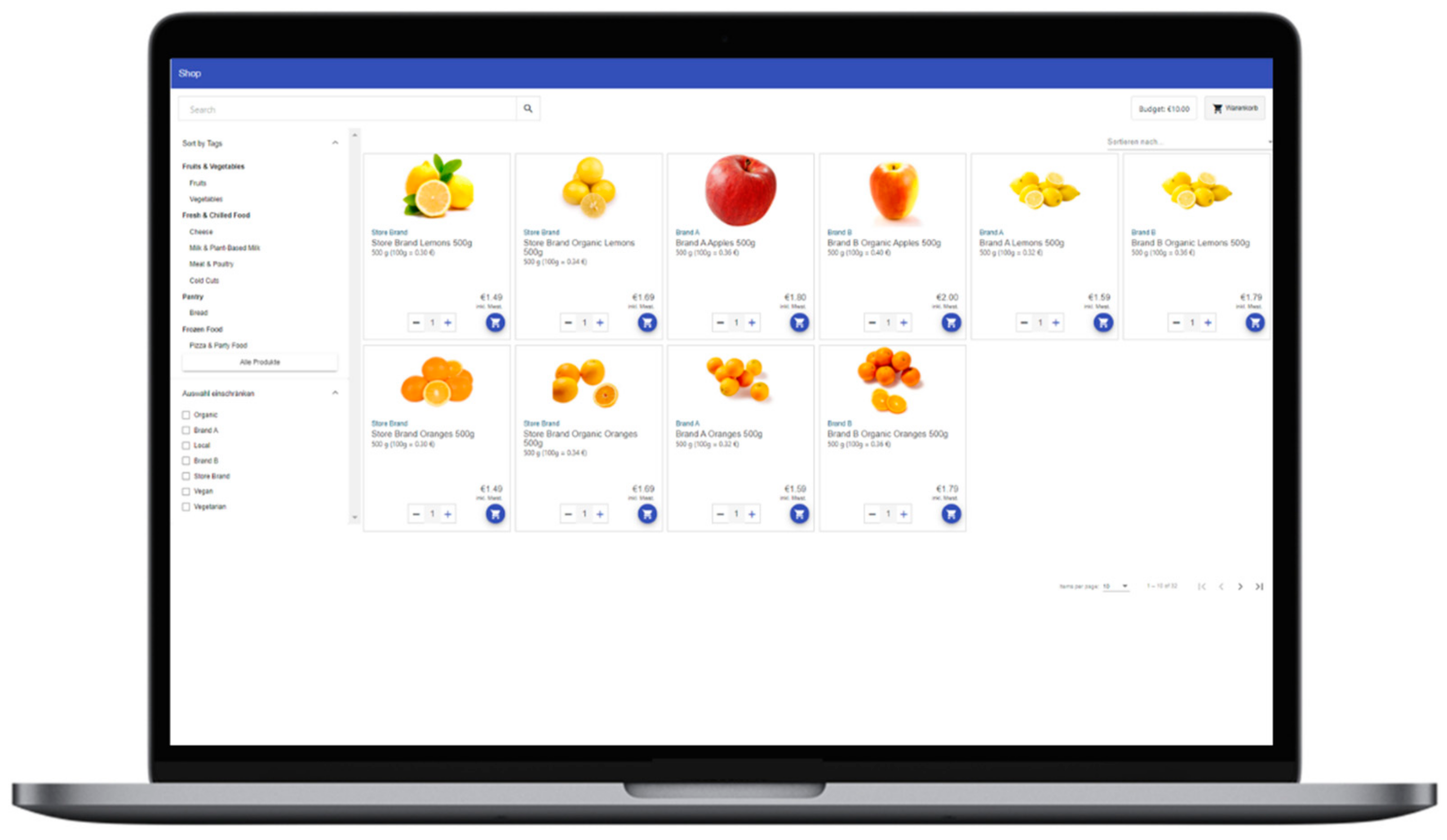
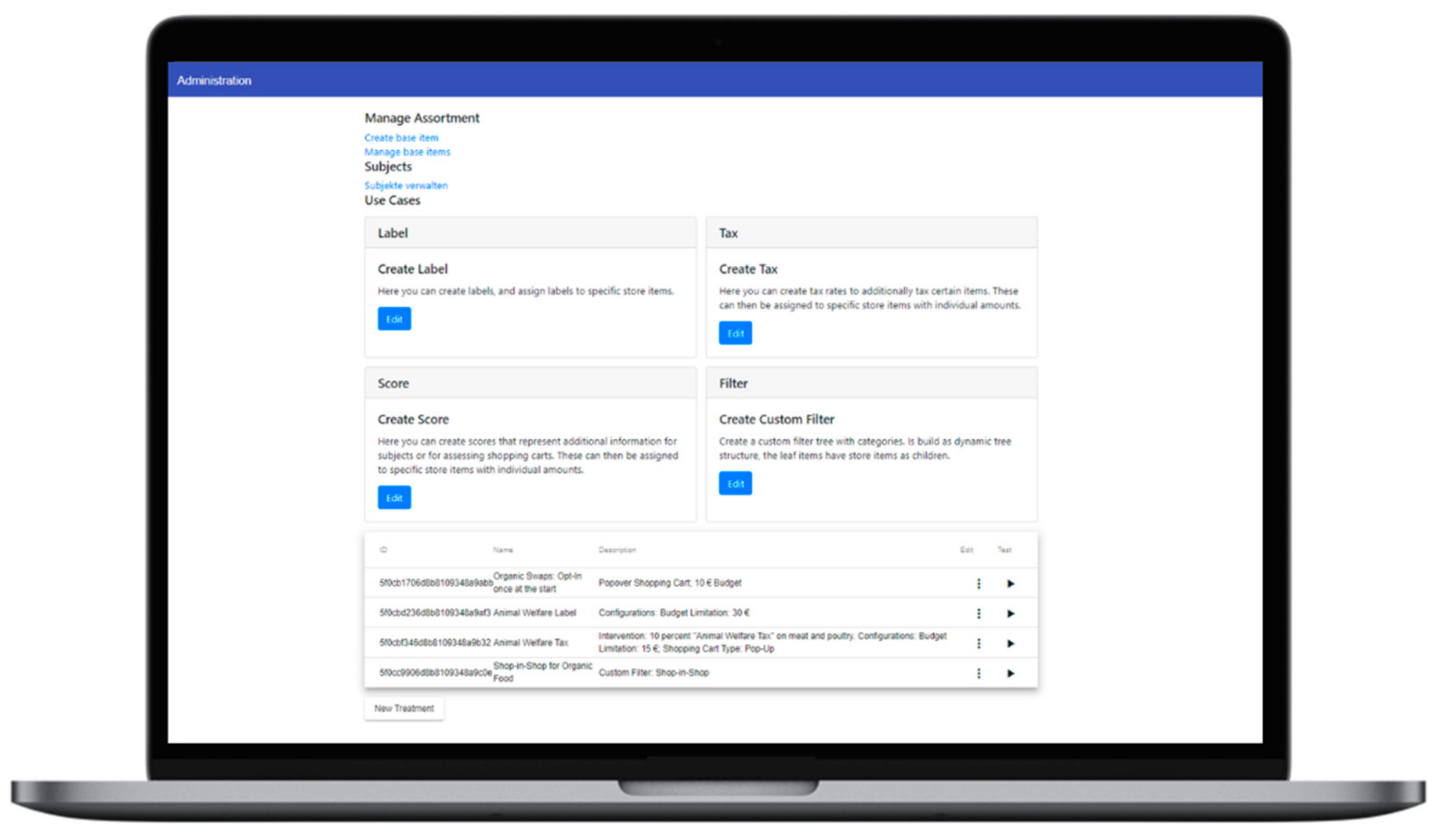
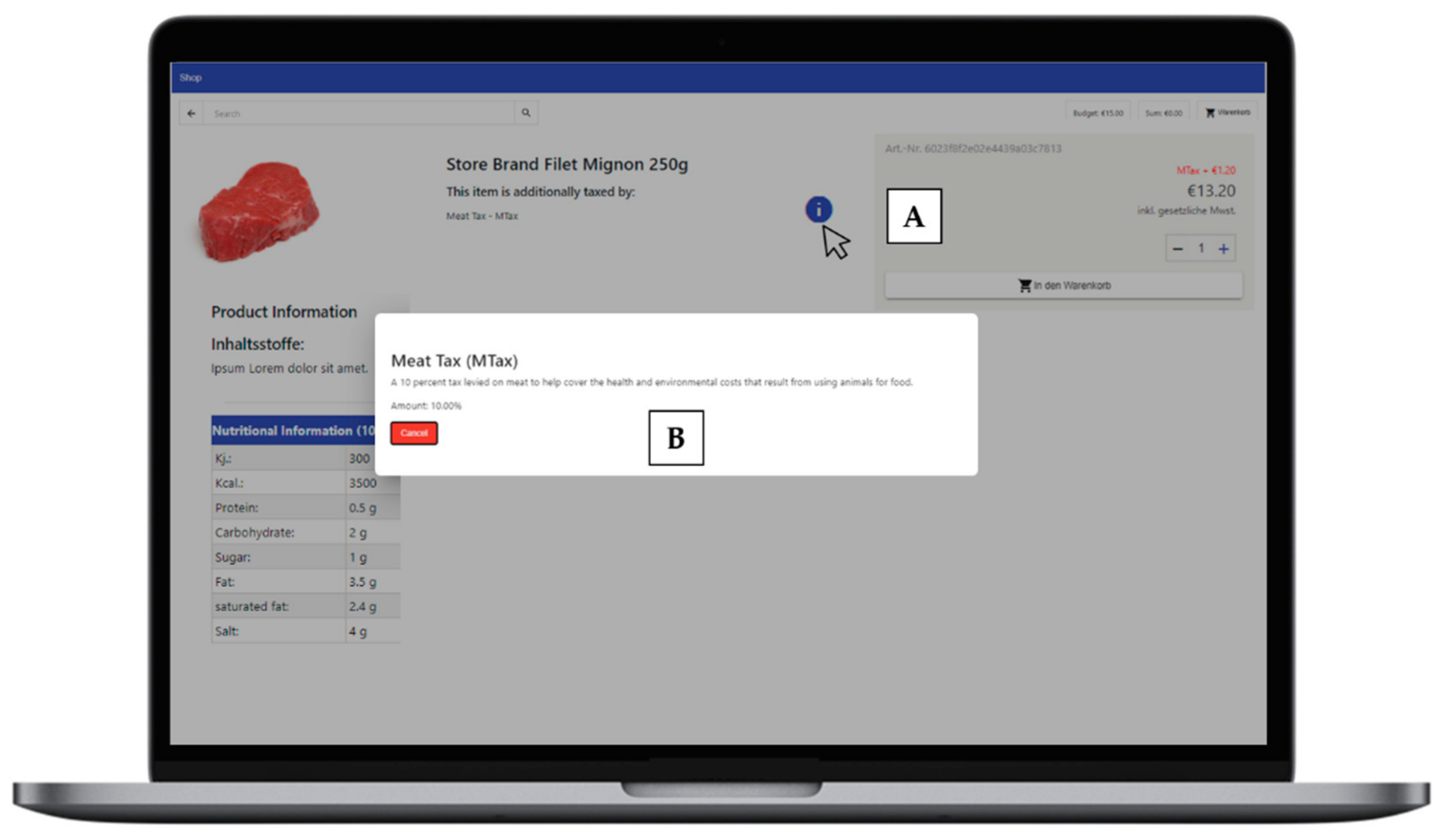

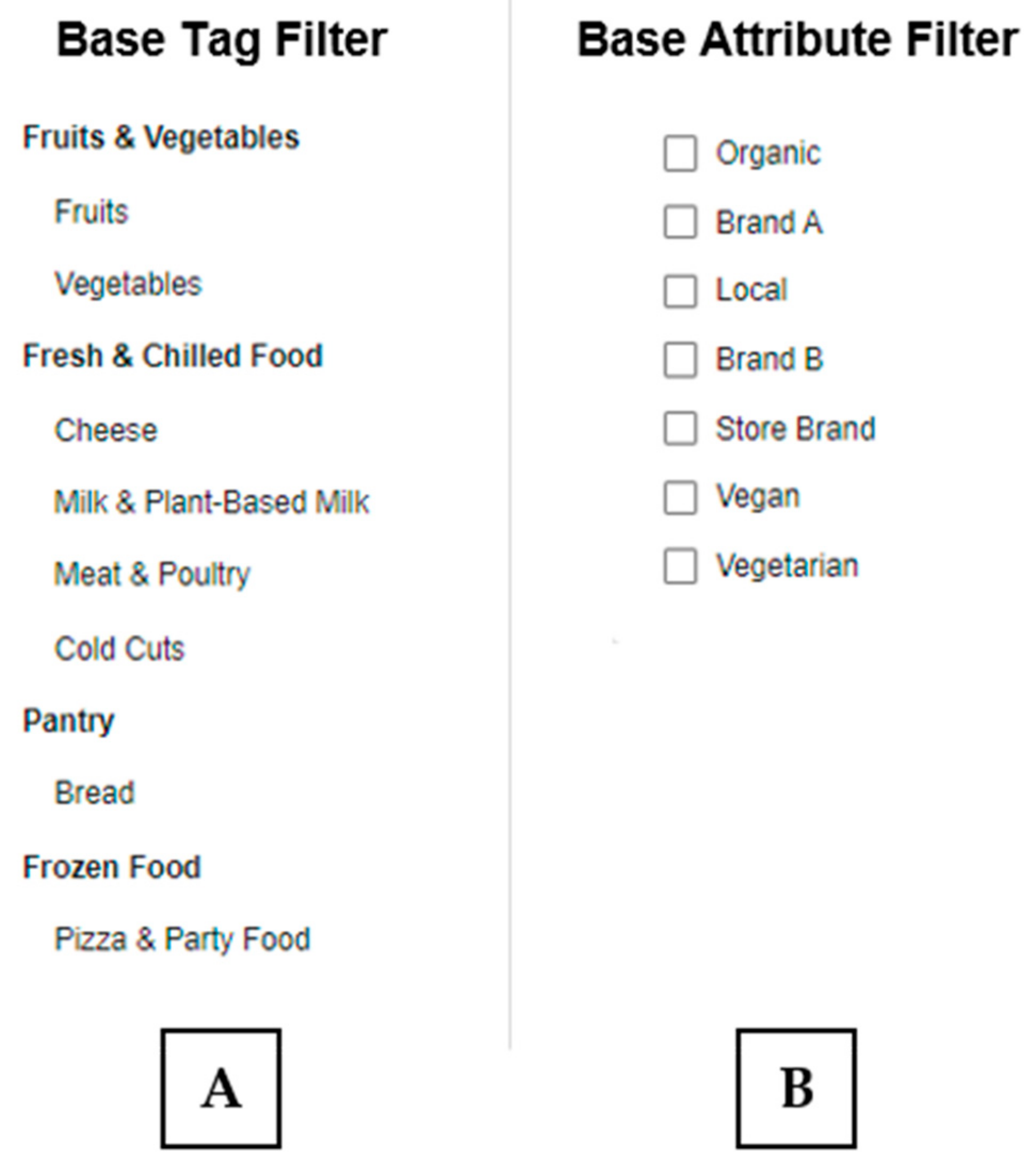
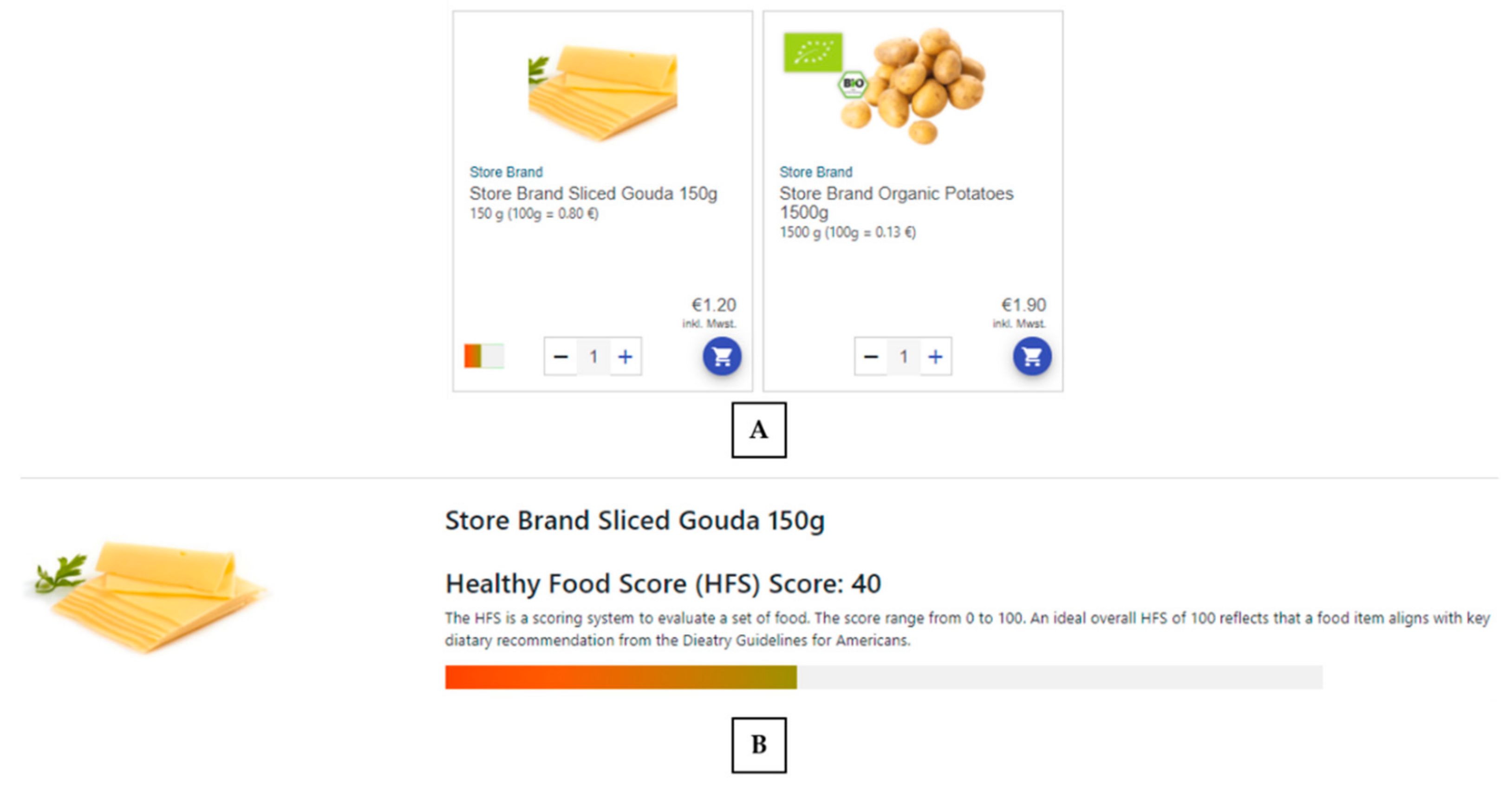
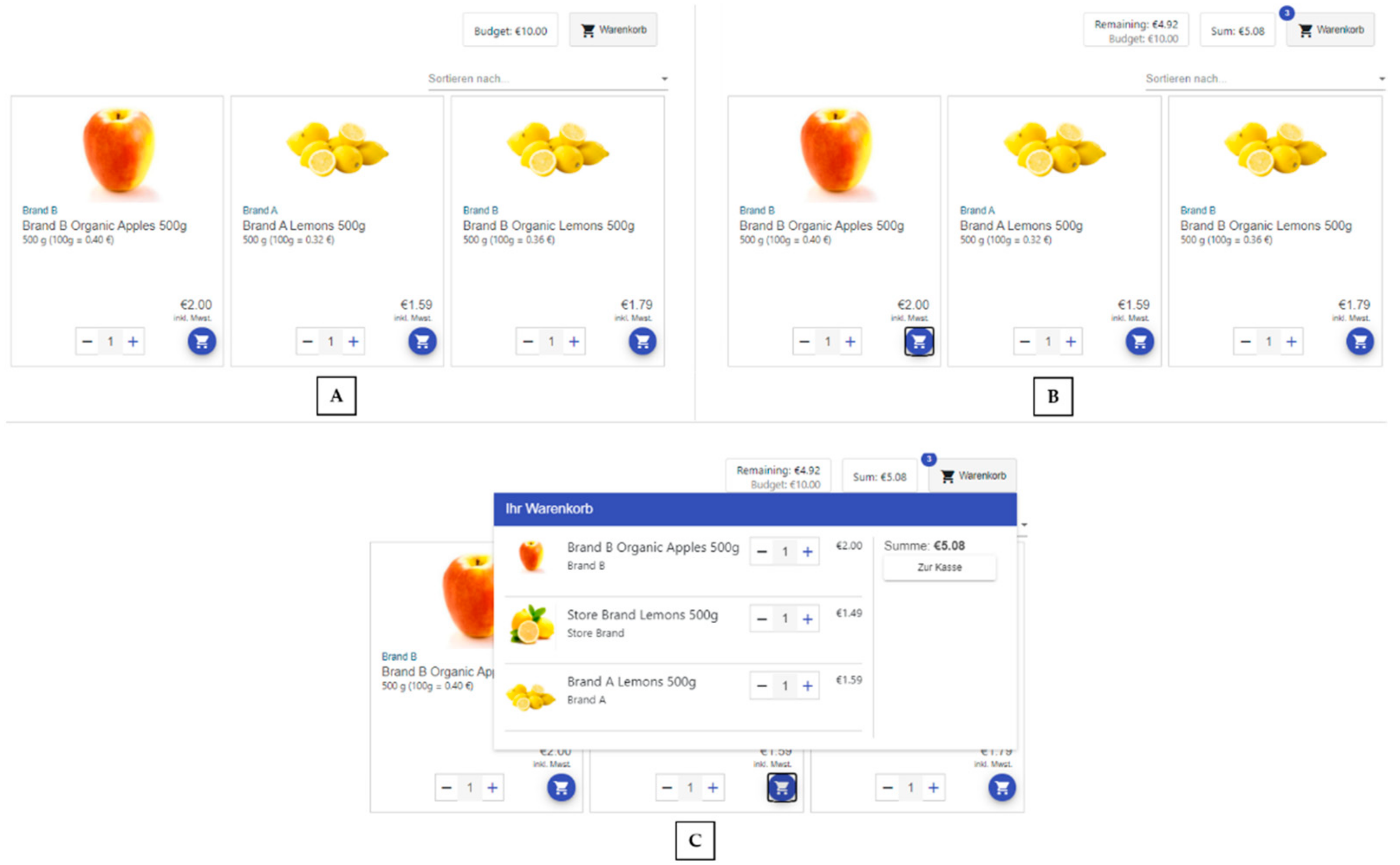
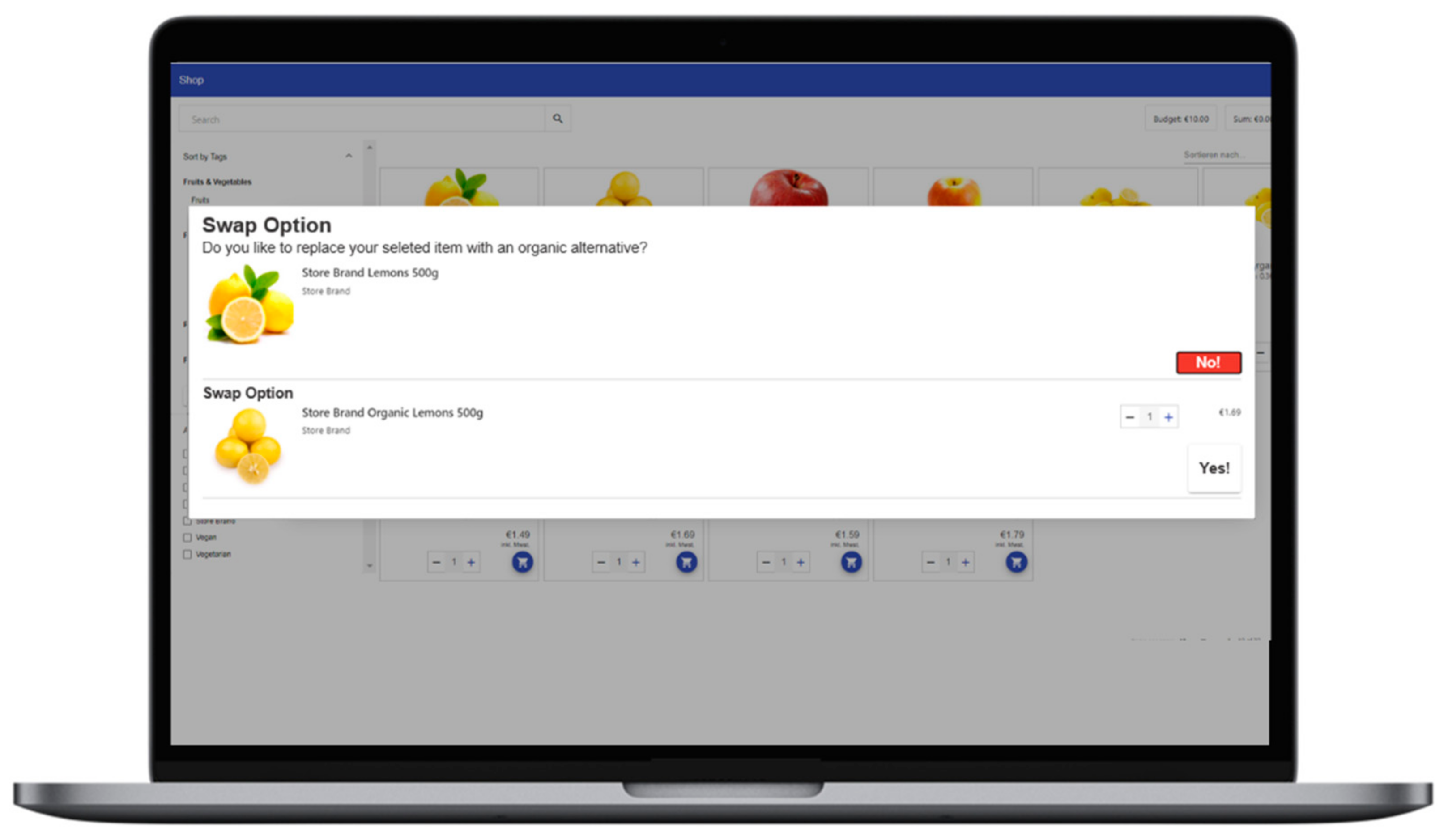
| Variable | Description | Mean | Median | SD |
|---|---|---|---|---|
| A. General Satisfaction Score (GS) | To measure general satisfaction, we asked users (GS.01) about their satisfaction with their shopping experience, (GS.02) if their expectations of shopping in VOS have been met, and (GS.03) if they would buy from a real shop similar to VOS. | 4.92 | 5.66 | 1.15 |
| B. Information Quality Score (IQ) | Information Quality comprises three second-order constructs: understandability, reliability, and usefulness. | 5.52 | 5.59 | 0.71 |
| B.1. Understandability Score (USS) | To measure understandability, we asked subjects to rate whether or not product information was (IQ.01) unambiguous, (IQ.02) easy to read, (IQ.03) comprehensible, and (IQ.04) generally understandable. | 5.68 | 5.75 | 0.91 |
| B.2. Reliability Score (RS) | To measure reliability, we asked subjects to rate whether or not product information was (IQ.05) trustworthy, (IQ.06) accurate, (IQ.07) credible, and (IQ.08) reliable for making a purchase decision. | 5.73 | 5.75 | 0.69 |
| B.3. Usefulness Score (UFS) | To measure usefulness, we asked subjects to rate whether or not product information was (IQ.09) informative for the purchase decision, (IQ.10) valuable for making a purchase decision, and (IQ.11) useful for making a purchase decision. | 5.02 | 5.33 | 1.22 |
| C. System quality Score (SQ) | System Quality comprises three second-order constructs: usability, user-friendliness, and navigation. | 5.43 | 5.81 | 0.98 |
| C.1. Usability Score (USA) | To measure usability, we asked subjects to evaluate VOS’s (SQ.01) responsiveness (e.g., quick reactions to queries), (SQ.02) performance (e.g., loading times of graphics), and (SQ.03) technological modernness. | 5.80 | 6.00 | 1.02 |
| C.2. User-friendliness Score (UFS) | To measure user-friendliness, we asked subjects to rate whether or not (SQ.04) the store’s layout is simple, (SQ.05) it is easy to use, (SQ.06) it is well organized, (SQ.07) it is possible to see as many products as possible at a glance, (SQ.08) it is possible to easily compare different products, (SQ.09) multiple product images and display formats are available (e.g., zoomed images), (SQ.10) its design is straightforward, and (SQ.11) it is user-friendly in general. | 5.22 | 5.63 | 1.09 |
| C.3. Navigation Score (NS) | To evaluate the site’s navigation, we asked subjects to rate whether or not (SQ.12) it has made it possible to (SQ.12) easily go back and forth between pages, (SQ.13) locate the information they need with just a few clicks, (SQ.14) locate the products they prefer as quickly as possible, (SQ.15) edit their shopping cart as quickly and easily as possible (e.g., to add products), and (SQ.16) easily navigate. | 5.56 | 6.00 | 1.21 |
| D. Realism Level Score (RL) | To measure the realism level of our online shopping simulation, we asked subjects whether or not (RL.01) VOS has given them the feeling of using a real online store, (RL.02) their purchases correspond to their regular shopping behavior, (RL.03) their decisions reflect their regular in-store behavior (e.g., product comparisons), and (RL.04) their gathered information while shopping reflects their behavior on a regular shopping trip. | 5.28 | 5.50 | 0.94 |
| Variable | Description | Min. | Max | Mean | Median | SD |
|---|---|---|---|---|---|---|
| Total Spending (in €) | The sum of all items purchased. | 20.66 | 371.55 | 46.87 | 33.03 | 63.69 |
| Total Spending on Organic Items (in €) | The sum of all organic items purchased. | 0.00 | 33.13 | 9.27 | 6.87 | 8.34 |
| Relative Spending on Organic Items | The share of spending for organic items in relation to total purchases. | 0.00 | 0.77 | 0.27 | 0.19 | 0.22 |
| Basket Size | The total number of all items purchased. | 12.00 | 234.00 | 27.17 | 18.00 | 40.47 |
| Number of Unique Items | The sum of all unique items purchased. | 0.00 | 0.61 | 0.22 | 0.18 | 0.17 |
| Share of Organic Items | The share of organic items in total purchases. | 1.00 | 15.00 | 6.72 | 6.00 | 3.61 |
| Number of Store Brands | The sum of items from store brands purchased. | 0.01 | 0.75 | 0.34 | 0.35 | 0.18 |
| Number of Organic Items by a Store Brand | The share of items from store brands in total purchases. | 0.00 | 11.00 | 3.10 | 3.00 | 2.76 |
| Share of Store Brands on Organic Items | The sum of purchased organic items offered by store brands. | 0.00 | 1.00 | 0.74 | 0.85 | 0.31 |
| Variable | Description | Min. | Max | Mean | Median | SD |
|---|---|---|---|---|---|---|
| Shopping Duration (min:sec) | The duration between when a subject had successfully logged onto our virtual online supermarket website and subjects’ last visit to the VSC full-screen site * | 01:22 | 501:16 | 37:05 | 06:19 | 109:14 |
| First Orientation Time (min:sec) | Time taken between the start of the shopping task and adding the first item to the cart. | 00:59 | 00:04 | 02:38 | 00:50 | 00:44 |
| Product Adds (to cart) | Number of unique items added to VSC. | 12.00 | 29.00 | 14.38 | 13.00 | 4.35 |
| Product Removes (from cart) | Number of unique items removed from the VSC. | 0.00 | 3.00 | 0.55 | 0.00 | 0.87 |
| Product amount changes (in cart) | Number of amount changes in the VSC during shopping. | 0.00 | 13.00 | 1.00 | 0.00 | 2.74 |
| Total Cart Adjustments | Sum of all adjustments (PA, PR, and PC) to the VSC. | 12.00 | 35.00 | 15.93 | 14.00 | 6.12 |
| Detailed product views | Sum of all product pages a consumer has visited during shopping. | 0.00 | 16.00 | 2.93 | 2.00 | 3.85 |
| Cart-to-Detail Ratio | Ratio of the number of items added to the VSC to the number of product-detail views. | 0.00 | 1.14 | 0.22 | 0.14 | 0.28 |
| Add-to-Purchase Ratio | Ratio of the number of items bought to the number of items added to VSC. | 0.80 | 1.00 | 0.96 | 1.00 | 0.53 |
| Total user interactions | Number of all user interactions that link a subject to another (sub)page of the VSC or changes the view of the currently seen (sub)page. | 3.00 | 460.00 | 83.00 | 47.00 | 105.28 |
| Interactions-to- Purchase Ratio | Number of user interaction in relation to the basket size. | 0.23 | 23.21 | 5.71 | 3.62 | 6.09 |
Publisher’s Note: MDPI stays neutral with regard to jurisdictional claims in published maps and institutional affiliations. |
© 2021 by the authors. Licensee MDPI, Basel, Switzerland. This article is an open access article distributed under the terms and conditions of the Creative Commons Attribution (CC BY) license (https://creativecommons.org/licenses/by/4.0/).
Share and Cite
Engelbrecht, N.; Lembcke, T.-B.; Brendel, A.B.; Bizer, K.; Kolbe, L.M. The Virtual Online Supermarket: An Open-Source Research Platform for Experimental Consumer Research. Sustainability 2021, 13, 4375. https://doi.org/10.3390/su13084375
Engelbrecht N, Lembcke T-B, Brendel AB, Bizer K, Kolbe LM. The Virtual Online Supermarket: An Open-Source Research Platform for Experimental Consumer Research. Sustainability. 2021; 13(8):4375. https://doi.org/10.3390/su13084375
Chicago/Turabian StyleEngelbrecht, Nils, Tim-Benjamin Lembcke, Alfred Benedikt Brendel, Kilian Bizer, and Lutz M. Kolbe. 2021. "The Virtual Online Supermarket: An Open-Source Research Platform for Experimental Consumer Research" Sustainability 13, no. 8: 4375. https://doi.org/10.3390/su13084375
APA StyleEngelbrecht, N., Lembcke, T.-B., Brendel, A. B., Bizer, K., & Kolbe, L. M. (2021). The Virtual Online Supermarket: An Open-Source Research Platform for Experimental Consumer Research. Sustainability, 13(8), 4375. https://doi.org/10.3390/su13084375






